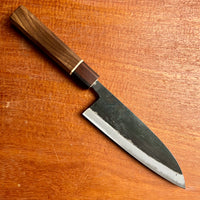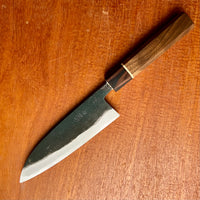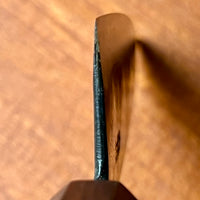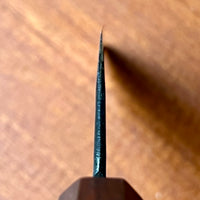Nishida San is a solo blacksmith working out of Kumumoto. Each one is traditionally made from start to finish by him.
This traditional line of knives is clad with a soft iron, so extra care must be practiced to prevent rust. The natural patina will look lovely with these.
HRC : 61
The Funayuki (舟行) is a traditional Japanese knife that is used by fisherman aboard their boats; indeed, Funayuki literally translates in to English as "going on boat". These knives are often used by fishermen to clean, fillet and quality test small or medium-sized fish. However, in the past, fishermen also used their Funayuki to prepare food for themselves (either out at sea, or back at port), so the knife also had to be capable of cutting meat, vegetables and fruit - just like the similarly versatile Santoku and Gyuto.
Use & Care
- Do not attempt to cut, hit or chop frozen products or bones. The blade can chip or break with improper use.
- Hand wash with warm water and towel dry. Never put the knife in a dishwasher, nor soak it in water. Ever!
- Use a sharpening stone to maintain the sharpness of the blade.
- Do not use on hard melons or items that may torque the blade.
- Use a sharpening stone to maintain the sharpness of the blade.
- Description
Nishida San is a solo blacksmith working out of Kumumoto. Each one is traditionally made from start to finish by him.
This traditional line of knives is clad with a soft iron, so extra care must be practiced to prevent rust. The natural patina will look lovely with these.
HRC : 61
The Funayuki (舟行) is a traditional Japanese knife that is used by fisherman aboard their boats; indeed, Funayuki literally translates in to English as "going on boat". These knives are often used by fishermen to clean, fillet and quality test small or medium-sized fish. However, in the past, fishermen also used their Funayuki to prepare food for themselves (either out at sea, or back at port), so the knife also had to be capable of cutting meat, vegetables and fruit - just like the similarly versatile Santoku and Gyuto.
Use & Care
- Do not attempt to cut, hit or chop frozen products or bones. The blade can chip or break with improper use.
- Hand wash with warm water and towel dry. Never put the knife in a dishwasher, nor soak it in water. Ever!
- Use a sharpening stone to maintain the sharpness of the blade.
- Do not use on hard melons or items that may torque the blade.
- Use a sharpening stone to maintain the sharpness of the blade.







